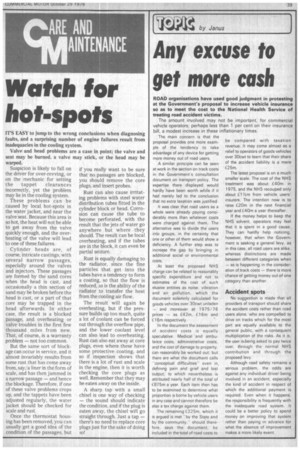Watch for hot-spots
Page 41

If you've noticed an error in this article please click here to report it so we can fix it.
ITS EASY to jump to the wrong conclusions when diagnosing faults, and a surprising number of engine failures result from inadequacies in the cooling system.
Valve and head problems are a case in point; the valve and seat may be burned, a valve may stick, or the head may be warped.
Suspicion is likely to fall on the driver for over-revving, or on the mechanic for setting the tappet clearances incorrectly, yet the problem may lie in the cooling system.
These problems can be caused by local hot-spots in the water jacket, and near the valve seat. Because this area is so hot, the heat will not be able to get away from the valve quickly enough, and the overheating of the valve will lead to one of these failures.
Cylinder heads are, of course, intricate castings, with several narrow passages, especially around the valves and injectors. These passages are formed by the sand cores when the head is cast, and occasionally a thin section of sand may be broken before the head is cast, or a part of that core may be trapped in the head afterwards. In either case, the result is a blocked passage, and overheating or valve troubles in the first few thousand miles from new. That, of course, is a warranty problem — not too common.
But the same sort of blockage can occur in service, and it almost invariably results from some rust that has come away from, say/ a liner in the form of scale, and has then jammed in a narrow passage — and hence the blockage. Therefore, if one of these valve problems crops up, and the tappets have been adjusted regularly, the water jacket should be checked for scale and rust.
Once the thermostat housing has been removed, you can usually get a good idea of the condition of the passages, but if you really want to be sure that no passages are blocked, you should remove the core plugs, and insert probes.
Rust can also cause irritating problems with steel water distribution tubes fitted in the cylinder block or head. Corrosion can cause the tube to become perforated, with the result that the jets of water go anywhere but where they should. The result can be local overheating, and if the tubes are in the block, it can even be partial seizure.
Rust is equally damaging to the radiator, since the fine particles that get into the tubes have a tendency to form a coating, sO that the flow is reduced, as is the ability of the radiator to transfer the heat from the cooling air flow.
The result will again be overheating, but if the pressure builds up too much, quite a lot of coolant can be forced out through the overflow pipe, and the lower coolant level can also lead to overheating. Rust can also eat away at core plugs, even where these have some protective coating, and so if inspection shows that there is a lot of rust and scale in the engine, then it is worth checking the core plugs as well. Remember that they may be eaten away on the inside.
A sharp tap with a small chisel is one way of checking — the sound should indicate the condition, and if the plug is eaten away, the chisel will go straight through. Just a tap — there's no need to replace core plugs just for the sake of doing so!








































































































